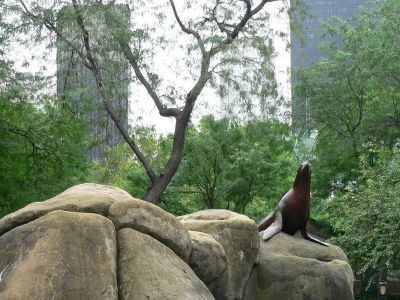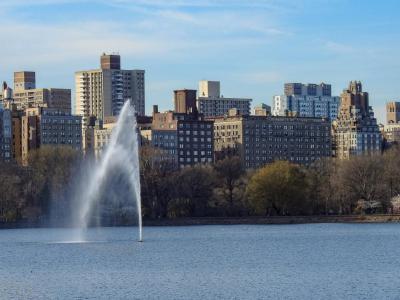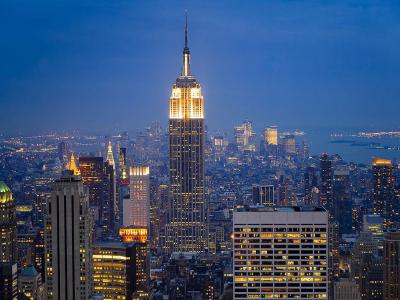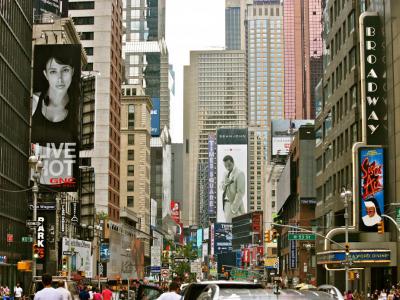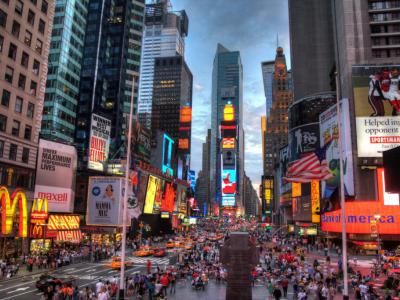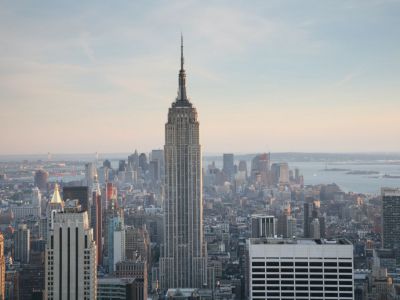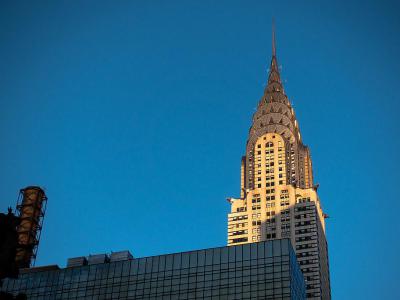Custom Walk in New York, New York by psfiji71_53aa3 created on 2025-01-09
Guide Location: USA » New York
Guide Type: Custom Walk
# of Sights: 8
Tour Duration: 9 Hour(s)
Travel Distance: 24.2 Km or 15 Miles
Share Key: 3HXXP
Guide Type: Custom Walk
# of Sights: 8
Tour Duration: 9 Hour(s)
Travel Distance: 24.2 Km or 15 Miles
Share Key: 3HXXP
How It Works
Please retrieve this walk in the GPSmyCity app. Once done, the app will guide you from one tour stop to the next as if you had a personal tour guide. If you created the walk on this website or come to the page via a link, please follow the instructions below to retrieve the walk in the app.
Retrieve This Walk in App
Step 1. Download the app "GPSmyCity: Walks in 1K+ Cities" on Apple App Store or Google Play Store.
Step 2. In the GPSmyCity app, download(or launch) the guide "New York Map and Walking Tours".
Step 3. Tap the menu button located at upper right corner of the "Walks" screen and select "Retrieve custom walk". Enter the share key: 3HXXP
1) Central Park Zoo
One of the first experiments in creating natural habitats for diverse animals in an urban setting, the Central Park Zoo is, expectedly, small-scale and very compact, but hosts a surprisingly good variety of animals from tropical, temperate, and polar parts of the world in well laid out exhibits. The main attractions are the sea lions, snow leopards, penguins, and bears, though some would rather pick the rainforest-inspired "Tropic Zone" as their favorite – it is a house filled with rare tropical birds, reptiles, and small mammals. One can spend more than a couple of hours here to enjoy every part.
The zoo is certainly the perfect size for children, as it has just the right number of attractions and exhibits to keep up their curiosity, including a separate petting zoo with animals such as goats, sheep or llamas (bring quarters buy food to feed them). There is also a 4D cinema experience – only 15mins long but worth a watch and pretty entertaining.
To get the most out of a visit, it's best to try to get to see all the scheduled 'highlight' events such as the feeding of penguins and sea lions, because the animals are a joy to watch working with their trainers.
Tip:
Online tickets are only available for the "Total Experience", which includes admission to the main zoo, the children's zoo, and the one entry to the 4D theatre. If that doesn't suit your needs, step right up to the ticket window to purchase a general admission ticket.
The zoo is certainly the perfect size for children, as it has just the right number of attractions and exhibits to keep up their curiosity, including a separate petting zoo with animals such as goats, sheep or llamas (bring quarters buy food to feed them). There is also a 4D cinema experience – only 15mins long but worth a watch and pretty entertaining.
To get the most out of a visit, it's best to try to get to see all the scheduled 'highlight' events such as the feeding of penguins and sea lions, because the animals are a joy to watch working with their trainers.
Tip:
Online tickets are only available for the "Total Experience", which includes admission to the main zoo, the children's zoo, and the one entry to the 4D theatre. If that doesn't suit your needs, step right up to the ticket window to purchase a general admission ticket.
2) Jacqueline Kennedy Onassis Reservoir
In the world's most famous park, there are several artificial lakes and ponds, but all small in size when compared to the magnificent billion-gallon Reservoir. The world's largest man-made lake back in the 1860s, it's visible from up high when flying over New York City, but you're better off seeing it from the ground while walking around – or, if you feel a bit more energetic, why not take a run?
A long-time favorite for sporty uptown residents, its raised 1.6-mile running track is a neat place to get 360-degree views of the skyline and, at night, the city lights twinkling in the distance.
Even when walks get long, they're certainly not strenuous due to the flat surface. Bikes aren't allowed on the path and foot traffic moves "one-way" counter-clockwise. The outside ring is better for runners, as it's much wider and less crowded.
The landscape north of the Reservoir, in the appropriately named North Woods, feels more like upstate New York than Manhattan. The 90-acre area contains the Loch, which is more like a walking path along a stream, and the Ravine, which conceals fairly dense wood along with five small waterfalls. It is a place where even seasoned New Yorkers can lose themselves.
A long-time favorite for sporty uptown residents, its raised 1.6-mile running track is a neat place to get 360-degree views of the skyline and, at night, the city lights twinkling in the distance.
Even when walks get long, they're certainly not strenuous due to the flat surface. Bikes aren't allowed on the path and foot traffic moves "one-way" counter-clockwise. The outside ring is better for runners, as it's much wider and less crowded.
The landscape north of the Reservoir, in the appropriately named North Woods, feels more like upstate New York than Manhattan. The 90-acre area contains the Loch, which is more like a walking path along a stream, and the Ravine, which conceals fairly dense wood along with five small waterfalls. It is a place where even seasoned New Yorkers can lose themselves.
3) Rockefeller Center (must see)
Back in 1801, a New York physician named David Hosack bought 22 acres of empty land from the city with an aim to establish America’s first botanical garden. And for the next ten years, the Elgin Botanic Garden really did bloom—until funding wilted, the plants went wild, and Columbia University had to step in to take over the property in 1823.
Fast-forward a century to 1926, when the Metropolitan Opera went searching for a grand new home. Columbia leased the land to its generous patron, John D. Rockefeller, Jr., setting the stage for a glittering cultural palace. Then the stock market crashed in 1929, the opera backed out, and Rockefeller found himself with prime New York real estate and no tenant. So, he pivoted—and decided to build a mass-media powerhouse instead.
In 1930, after months of negotiations involving Radio Corporation of America, National Broadcasting Company, and Radio-Keith-Orpheum, the plan was set: an entertainment complex of unprecedented scale. To make room, 228 buildings were cleared and 4,000 tenants relocated. Early name ideas included “Radio City,” “Rockefeller City,” and the dramatic “Metropolitan Square,” before the now-famous title finally stuck.
Today, Rockefeller Center stretches across all of Doctor Hosack’s original 22 acres—though the botanicals have long been replaced with 14 Art Deco buildings, a standalone tower along 51st Street, and four more rising on the west side of Sixth Avenue. There are rooftop gardens, but you’ll have to crane your neck to see anything green.
On the west side sits Radio City Music Hall, still flashing its neon glamour. And at the heart of it all lies the sunken Lower Plaza, praised by Chinese-American architect Ieoh Ming Pei as “the most successful open space in the United States, perhaps in the world.” Most visitors simply know it as “the place with the ice rink,” which has been delighting skaters since 1936.
Then there’s the view. “Top of the Rock” offers three levels of indoor and outdoor decks with clear, cinematic vistas of the New York skyline. Back on the ground, the shops spread out in every direction—big names, small designers, and everything in between. It’s the kind of place where you realize: shopping isn’t just about what you buy; it’s about where you buy it...
Fast-forward a century to 1926, when the Metropolitan Opera went searching for a grand new home. Columbia leased the land to its generous patron, John D. Rockefeller, Jr., setting the stage for a glittering cultural palace. Then the stock market crashed in 1929, the opera backed out, and Rockefeller found himself with prime New York real estate and no tenant. So, he pivoted—and decided to build a mass-media powerhouse instead.
In 1930, after months of negotiations involving Radio Corporation of America, National Broadcasting Company, and Radio-Keith-Orpheum, the plan was set: an entertainment complex of unprecedented scale. To make room, 228 buildings were cleared and 4,000 tenants relocated. Early name ideas included “Radio City,” “Rockefeller City,” and the dramatic “Metropolitan Square,” before the now-famous title finally stuck.
Today, Rockefeller Center stretches across all of Doctor Hosack’s original 22 acres—though the botanicals have long been replaced with 14 Art Deco buildings, a standalone tower along 51st Street, and four more rising on the west side of Sixth Avenue. There are rooftop gardens, but you’ll have to crane your neck to see anything green.
On the west side sits Radio City Music Hall, still flashing its neon glamour. And at the heart of it all lies the sunken Lower Plaza, praised by Chinese-American architect Ieoh Ming Pei as “the most successful open space in the United States, perhaps in the world.” Most visitors simply know it as “the place with the ice rink,” which has been delighting skaters since 1936.
Then there’s the view. “Top of the Rock” offers three levels of indoor and outdoor decks with clear, cinematic vistas of the New York skyline. Back on the ground, the shops spread out in every direction—big names, small designers, and everything in between. It’s the kind of place where you realize: shopping isn’t just about what you buy; it’s about where you buy it...
4) Broadway (must see)
Trying to follow Broadway back to its beginnings, you’d find yourself tracing a much older path: the Wickquasgeck Trail, a route carved into Manhattan in the times of New Amsterdam, long before New York dreamed of skyscrapers or neon marquees... That trail stretched up the island like a wandering spine, and when the Dutch arrived, they simply widened it and gave it a new name: Heeren (or “Gentlemen’s”) Way. The British, who arrived later, noticing how wide the street really was, promptly declared it Broadway—a name that clearly stuck.
Today’s Broadway runs a lot farther than its original ancestor. It launches from Bowling Green at Manhattan’s southern tip, slips through the boroughs, wanders into Westchester County, and keeps going until it reaches Sleepy Hollow. If you’re searching for New York’s oldest continuous street, this is the one.
Jump to 1907, when part of Broadway—stretching from Times Square to Sherman Square—earned a new identity as Automobile Row. Car dealerships, repair shops, and glittering showrooms lined both sides, turning the street into a motor-age catwalk. Over time, the traffic patterns tightened, and Broadway became mainly a one-way river of cars.
In recent decades, though, the city has rewritten Broadway’s script. Cars have gradually ceded space to people, and sections of the street have transformed into pedestrian plazas, pocket parks, and bike lanes. Times Square, Duffy Square, and Herald Square traded honking horns for café tables and performers in painted outfits. Even Madison and Union Square saw Broadway narrow to make room for walkers instead of windshields.
At the southern end, near Bowling Green and City Hall Park, Lower Broadway still plays host to the city’s legendary ticker-tape parades—snowstorms of paper drifting from office towers as heroes of every kind roll past. These days, it’s more shredded confetti and fewer actual tickers, but the “Canyon of Heroes” effect remains.
And then there’s the stretch that needs no introduction: The Great White Way, a phrase coined in 1901 to describe Broadway’s theater district. Between 42nd and 53rd Streets, the lights burn bright, the marquees compete for your attention, and the plays and musicals rewrite themselves nightly through applause.
From colonial trail to cultural artery, Broadway carries centuries of stories—and somehow still finds room for more...
Today’s Broadway runs a lot farther than its original ancestor. It launches from Bowling Green at Manhattan’s southern tip, slips through the boroughs, wanders into Westchester County, and keeps going until it reaches Sleepy Hollow. If you’re searching for New York’s oldest continuous street, this is the one.
Jump to 1907, when part of Broadway—stretching from Times Square to Sherman Square—earned a new identity as Automobile Row. Car dealerships, repair shops, and glittering showrooms lined both sides, turning the street into a motor-age catwalk. Over time, the traffic patterns tightened, and Broadway became mainly a one-way river of cars.
In recent decades, though, the city has rewritten Broadway’s script. Cars have gradually ceded space to people, and sections of the street have transformed into pedestrian plazas, pocket parks, and bike lanes. Times Square, Duffy Square, and Herald Square traded honking horns for café tables and performers in painted outfits. Even Madison and Union Square saw Broadway narrow to make room for walkers instead of windshields.
At the southern end, near Bowling Green and City Hall Park, Lower Broadway still plays host to the city’s legendary ticker-tape parades—snowstorms of paper drifting from office towers as heroes of every kind roll past. These days, it’s more shredded confetti and fewer actual tickers, but the “Canyon of Heroes” effect remains.
And then there’s the stretch that needs no introduction: The Great White Way, a phrase coined in 1901 to describe Broadway’s theater district. Between 42nd and 53rd Streets, the lights burn bright, the marquees compete for your attention, and the plays and musicals rewrite themselves nightly through applause.
From colonial trail to cultural artery, Broadway carries centuries of stories—and somehow still finds room for more...
5) Times Square (must see)
Long before Manhattan’s tidy street plan straightened everything out, Broadway, unlike other streets in New York, followed an older native pathway, wandering freely up the island. This is why it slices across Seventh Avenue and 42nd Street, forming two triangular pockets, like a bow tie. The southern one is called Times Square, while the northern, Duffy Square, is named for World War I chaplain Father Francis P. Duffy, whose statue now watches over the crowds with admirable patience.
The stretch of Broadway from 41st to 53rd Streets goes by a different name: the Great White Way. That nickname wasn’t poetic exaggeration—those glowing billboards, marquees, and oversized posters once made the area one of the brightest electrified spots on Earth. Today, it’s still blazing away with advertisements for Broadway’s latest musicals and plays, pulling in nearly 50 million visitors a year. That’s roughly 330,000 people a day, all weaving through the lights, noise, and spectacle in search of something unforgettable.
Before it was Times Square, this chaotic crossroads answered to the far calmer name of Longacre Square. Everything changed in 1904, when New York Times publisher Adolph S. Ochs moved his newspaper into the brand-new Times Building—now known as One Times Square—and happily lent his name to the neighborhood. The Times moved out within a decade, but not before launching a little tradition in 1907: the New Year’s Eve Ball Drop. A century later, the glittering descent still draws over a million people every year, along with countless viewers around the world.
Today, Times Square is a fluorescent buffet of attractions—ABC’s Times Square Studios, Planet Hollywood, Bubba Gump Shrimp Company, and whichever character impersonator is bravest that day. The towering illuminated signs, nicknamed “spectaculars” or “jumbotrons,” compete with the neon bravado of Las Vegas and often win.
Amid all that glow, shoppers duck into stores like Gap, Old Navy, Forever 21, Levi’s, the Disney Store, Hershey’s Chocolate World, and M&M’s World—each one flashing its own brand of temptation. Whether you’re hunting for a souvenir, a show, or just a moment to stand still and stare, this Midtown crossroads remains New York at its most unfiltered and unmistakable.
The stretch of Broadway from 41st to 53rd Streets goes by a different name: the Great White Way. That nickname wasn’t poetic exaggeration—those glowing billboards, marquees, and oversized posters once made the area one of the brightest electrified spots on Earth. Today, it’s still blazing away with advertisements for Broadway’s latest musicals and plays, pulling in nearly 50 million visitors a year. That’s roughly 330,000 people a day, all weaving through the lights, noise, and spectacle in search of something unforgettable.
Before it was Times Square, this chaotic crossroads answered to the far calmer name of Longacre Square. Everything changed in 1904, when New York Times publisher Adolph S. Ochs moved his newspaper into the brand-new Times Building—now known as One Times Square—and happily lent his name to the neighborhood. The Times moved out within a decade, but not before launching a little tradition in 1907: the New Year’s Eve Ball Drop. A century later, the glittering descent still draws over a million people every year, along with countless viewers around the world.
Today, Times Square is a fluorescent buffet of attractions—ABC’s Times Square Studios, Planet Hollywood, Bubba Gump Shrimp Company, and whichever character impersonator is bravest that day. The towering illuminated signs, nicknamed “spectaculars” or “jumbotrons,” compete with the neon bravado of Las Vegas and often win.
Amid all that glow, shoppers duck into stores like Gap, Old Navy, Forever 21, Levi’s, the Disney Store, Hershey’s Chocolate World, and M&M’s World—each one flashing its own brand of temptation. Whether you’re hunting for a souvenir, a show, or just a moment to stand still and stare, this Midtown crossroads remains New York at its most unfiltered and unmistakable.
6) Empire State Building (must see)
Meet the undisputed champion of New York’s Art Deco era: the Empire State Building, a 102-story giant that rises over 1,450 feet above Midtown’s daily hustle. It once ruled as the tallest building on Earth; today it’s still impressive enough to hold a lineup of titles—seventh-tallest in New York, ninth in the United States, and still one of the tallest freestanding structures anywhere in the Americas.
Its name comes straight from New York’s proud nickname, the “Empire State,” and its streamlined design was the work of the Shreve, Lamb & Harmon architectural firm. Construction began in 1930, wrapped up just a year later, and replaced the former Waldorf-Astoria Hotel that once stood on the same block. From the start, the goal was simple: to build the biggest, boldest skyscraper the world had ever seen.
You’ll find this landmark in Midtown South, planted along Fifth Avenue between 34th and 35th Streets. Three observatories—on the 80th, 86th, and 102nd floors—offer wraparound views that make the city look like an architectural toy box. And thanks to its starring role in more than 250 films and TV shows, beginning with King Kong in 1933, the building’s Hollywood résumé is nearly as tall as the tower itself.
The exterior keeps things classic: Indiana limestone, granite, and clean geometric ornamentation that embodies Art Deco style without telling a story in symbols. The main entrance features metal doors framed by sleek vertical piers topped with sculpted eagles, along with a gold-lettered transom that proudly spells out the building’s name.
In recognition of its cultural and architectural significance, the Empire State Building was declared a New York City Landmark in 1980 and added to the National Register of Historic Places in 1986. Today, it remains one of Manhattan’s most enduring icons—an unmistakable marker on the skyline and an essential stop for anyone wanting to feel the full vertical spirit of New York.
Its name comes straight from New York’s proud nickname, the “Empire State,” and its streamlined design was the work of the Shreve, Lamb & Harmon architectural firm. Construction began in 1930, wrapped up just a year later, and replaced the former Waldorf-Astoria Hotel that once stood on the same block. From the start, the goal was simple: to build the biggest, boldest skyscraper the world had ever seen.
You’ll find this landmark in Midtown South, planted along Fifth Avenue between 34th and 35th Streets. Three observatories—on the 80th, 86th, and 102nd floors—offer wraparound views that make the city look like an architectural toy box. And thanks to its starring role in more than 250 films and TV shows, beginning with King Kong in 1933, the building’s Hollywood résumé is nearly as tall as the tower itself.
The exterior keeps things classic: Indiana limestone, granite, and clean geometric ornamentation that embodies Art Deco style without telling a story in symbols. The main entrance features metal doors framed by sleek vertical piers topped with sculpted eagles, along with a gold-lettered transom that proudly spells out the building’s name.
In recognition of its cultural and architectural significance, the Empire State Building was declared a New York City Landmark in 1980 and added to the National Register of Historic Places in 1986. Today, it remains one of Manhattan’s most enduring icons—an unmistakable marker on the skyline and an essential stop for anyone wanting to feel the full vertical spirit of New York.
7) Chrysler Building
For almost a year (11 months) prior to the completion of the Empire State Building, the Chrysler Building enjoyed the status of the world's tallest skyscraper. It was erected at an enormous rate of four floors a week, but despite the haste, no incident or accident occurred during the construction.
Commissioned by the automobile magnate Walter P. Chrysler, the skyscraper was designed by architect William Van Alen in 1928, and was meant to house the headquarters of the Chrysler company – hence the ornamentation in the lower floors, featuring steel automobile parts. Regarded by many well-known contemporary architects as the most beautiful structure in New York City, the building features art deco style with gradually decreasing steel arches studded with triangular windows. At 319 meters high and with 77 floors topped by a 38-meter spire, this is the highest steel-supported brick structure in the world. Initially, there was a viewing gallery on the 71st floor which was then closed in 1945. The marble-clad lobby has a mural in the ceiling, showing an automobile assembly line.
The Chrysler Building remains New York's best-loved skyscraper and was ranked 9th in the survey of the Favorite Architectural Memories in the US, ahead of many well-known landmarks, like the now destroyed World Trade Center. In 1976, the Chrysler Building was declared a National Historic Landmark.
Why You Should Visit:
Art-deco icon that looks good from any vantage point, but well worth a detour to take a closer look.
Tip:
If time is in shortage, just walk into the lobby to see the beautiful walls and floor. The ceiling is a unique work of art.
Commissioned by the automobile magnate Walter P. Chrysler, the skyscraper was designed by architect William Van Alen in 1928, and was meant to house the headquarters of the Chrysler company – hence the ornamentation in the lower floors, featuring steel automobile parts. Regarded by many well-known contemporary architects as the most beautiful structure in New York City, the building features art deco style with gradually decreasing steel arches studded with triangular windows. At 319 meters high and with 77 floors topped by a 38-meter spire, this is the highest steel-supported brick structure in the world. Initially, there was a viewing gallery on the 71st floor which was then closed in 1945. The marble-clad lobby has a mural in the ceiling, showing an automobile assembly line.
The Chrysler Building remains New York's best-loved skyscraper and was ranked 9th in the survey of the Favorite Architectural Memories in the US, ahead of many well-known landmarks, like the now destroyed World Trade Center. In 1976, the Chrysler Building was declared a National Historic Landmark.
Why You Should Visit:
Art-deco icon that looks good from any vantage point, but well worth a detour to take a closer look.
Tip:
If time is in shortage, just walk into the lobby to see the beautiful walls and floor. The ceiling is a unique work of art.
Sight description based on Wikipedia.
8) Statue of Liberty (must see)
In modern times, few are aware that the world-renowned Statue of Liberty in New York Harbor bears the full title of "Liberty Enlightening the World" (or "La Liberté éclairant le monde" in French). The reason for its French designation lies in the fact that this colossal copper figure was a gift from France.
Frédéric Auguste Bartholdi, the French sculptor, created the statue, drawing inspiration from the words of his compatriot, Édouard René de Laboulaye, a law professor and politician who believed that a monument celebrating American independence should be a joint endeavor between the French and American people. True to this vision, France financed the statue while the United States provided the site and constructed the pedestal.
Every element of the statue was crafted in France. The metal framework, in particular, was fashioned by Gustave Eiffel, renowned for his iconic creation, the Eiffel Tower in Paris (which was completed three years later in 1889). The statue's components were shipped in crates across the Atlantic and assembled atop the finished pedestal on what was then known as Bedloe's Island (now Liberty Island). Bartholdi deliberately chose this location, as he envisioned that passing vessels would sail by, and passengers, particularly those visiting the U.S. for the first time, would perceive the statue as a welcoming symbol.
On October 28, 1886, the statue was dedicated in a ceremony that coincided with the centennial anniversary of the signing of the U.S. Declaration of Independence. President Grover Cleveland presided over the momentous occasion.
The robed female figure represents Libertas, the Roman goddess of freedom. She holds a torch aloft in one hand and carries a tabula ansata, a tablet evoking the concept of law, inscribed with the date of the U.S. Declaration of Independence, July 4, 1776, in the other. At her feet lie a broken shackle and a chain, symbolizing the nation's abolition of slavery.
Popular accounts, though unverified, claim that the sculptor modeled the woman's face after his own mother, Charlotte Beysser Bartholdi. He intentionally designed the figure with a strong, uncomplicated silhouette, which would be accentuated by its prominent position in the harbor, allowing viewers sailing toward Manhattan to perceive the statue from varying perspectives.
Presently, visitors can explore the interior of the statue through a glass ceiling, enhanced lighting, and a surrounding video system. They are free to roam Liberty Island at their leisure, appreciating the serene surroundings, visiting the museum, and perusing nearby gift shops.
Frédéric Auguste Bartholdi, the French sculptor, created the statue, drawing inspiration from the words of his compatriot, Édouard René de Laboulaye, a law professor and politician who believed that a monument celebrating American independence should be a joint endeavor between the French and American people. True to this vision, France financed the statue while the United States provided the site and constructed the pedestal.
Every element of the statue was crafted in France. The metal framework, in particular, was fashioned by Gustave Eiffel, renowned for his iconic creation, the Eiffel Tower in Paris (which was completed three years later in 1889). The statue's components were shipped in crates across the Atlantic and assembled atop the finished pedestal on what was then known as Bedloe's Island (now Liberty Island). Bartholdi deliberately chose this location, as he envisioned that passing vessels would sail by, and passengers, particularly those visiting the U.S. for the first time, would perceive the statue as a welcoming symbol.
On October 28, 1886, the statue was dedicated in a ceremony that coincided with the centennial anniversary of the signing of the U.S. Declaration of Independence. President Grover Cleveland presided over the momentous occasion.
The robed female figure represents Libertas, the Roman goddess of freedom. She holds a torch aloft in one hand and carries a tabula ansata, a tablet evoking the concept of law, inscribed with the date of the U.S. Declaration of Independence, July 4, 1776, in the other. At her feet lie a broken shackle and a chain, symbolizing the nation's abolition of slavery.
Popular accounts, though unverified, claim that the sculptor modeled the woman's face after his own mother, Charlotte Beysser Bartholdi. He intentionally designed the figure with a strong, uncomplicated silhouette, which would be accentuated by its prominent position in the harbor, allowing viewers sailing toward Manhattan to perceive the statue from varying perspectives.
Presently, visitors can explore the interior of the statue through a glass ceiling, enhanced lighting, and a surrounding video system. They are free to roam Liberty Island at their leisure, appreciating the serene surroundings, visiting the museum, and perusing nearby gift shops.
